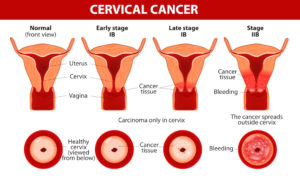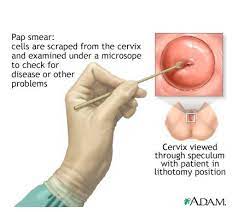HOW TO GET DIAGNOSE FOR CERVICAL CANCER:
Key Points to remember about cervical cancer:
- Cervical cancer is a disease in which malignant (cancer) cells form in the cervix.
- Screening for cervical cancer using the Pap test has decreased the number of new cases of cervical cancer and the number of deaths due to cervical cancer since 1950.
- Human papillomavirus (HPV) infection is the major risk factor for cervical cancer.
1-Screening is looking for cancer before a person has any symptoms. This can help find cancer at an early stage. When abnormal tissue or cancer is found early, it may be easier to treat. By the time symptoms appear, cancer may have begun to spread.
Know this about screening:
- Tests are used to screen for different types of cancer when a person does not have symptoms.
- Studies show that screening for cervical cancer helps decrease the number of deaths from the disease.
- A Pap test is commonly used to screen for cervical cancer.
- After certain positive Pap test results, an HPV test may be done.
- An HPV test may be done with or without a Pap test to screen for cervical cancer.
- Samples for an HPV test may be self-collected.
- Screening tests for cervical cancer are being studied in clinical trials.
Scientists are trying to better understand which people are more likely to get certain types of cancer.
Cervical dysplasia occurs more often in women who are in their 20s and 30s. Death from cervical cancer is rare in women younger than 30 years and in women of any age who have regular screenings with the Pap test. The Pap test is used to detect cancer and changes that may lead to cancer. The chance of death from cervical cancer increases with age. In recent years, deaths from cervical cancer have been slightly higher in Black women younger than 50 years than in White women younger than 50 years. Deaths from cervical cancer are almost twice as likely in Black women older than 60 years than in White women older than 60 years.
Human papillomavirus (HPV) infection is the major risk factor for cervical cancer.
2.If cervical cancer is suspected, your doctor is likely to start with a thorough examination of your cervix. A special magnifying instrument (colposcope) is used to check for abnormal cells.
During the colposcopic examination, your doctor is likely to take a sample of cervical cells (biopsy) for laboratory testing. To obtain tissue, your doctor may use:
- Punch biopsy, which involves using a sharp tool to pinch off small samples of cervical tissue.
- Endocervical curettage, which uses a small, spoon-shaped instrument (curet) or a thin brush to scrape a tissue sample from the cervix
If the punch biopsy or endocervical curettage is worrisome, your doctor may perform one of the following tests:
- Electrical wire loop, which uses a thin, low-voltage electrified wire to obtain a small tissue sample. Generally this is done under local anesthesia in the office.
- Cone biopsy (conization), which is a procedure that allows your doctor to obtain deeper layers of cervical cells for laboratory testing. A cone biopsy may be done in a hospital under general anesthesia.
Staging the cervical cancer:

Cervical Cancer. Carcinoma of Cervix. Malignant neoplasm arising from cells in the cervix uteri. Vaginal bleeding. Vector diagram
If your doctor determines that you have cervical cancer, you’ll have further tests to determine the extent (stage) of your cancer. Your cancer’s stage is a key factor in deciding on your treatment.
Staging exams include:
- Imaging tests. Tests such as X-ray, CT, MRI and positron emission tomography (PET) help your doctor determine whether your cancer has spread beyond your cervix.
- Visual examination of your bladder and rectum. Your doctor may use special scopes to see inside your bladder and rectum.


